Analysis of Sensitivity and Decision Making: A Business Report
VerifiedAdded on 2023/01/11
|7
|1634
|86
Report
AI Summary
This report delves into the critical aspects of decision-making within a business context, emphasizing the significance of sensitivity analysis in evaluating project parameters and scenarios. It explores the justification for parameter selection and analyzes various scenarios, including macro and lower-level analyses, to assess potential outcomes. The report provides a comparative analysis of economic approaches and highlights the importance of the due diligence process, outlining its scope. Furthermore, it discusses the information needs of different stakeholders, such as competitors, customers, and trade unions. The conclusion underscores the role of effective decision-making in enhancing business profitability, while sensitivity analysis is presented as a crucial tool for examining model configurations and input parameters. The report also includes references to relevant books and journals.

Decision making
Paraphrase This Document
Need a fresh take? Get an instant paraphrase of this document with our AI Paraphraser
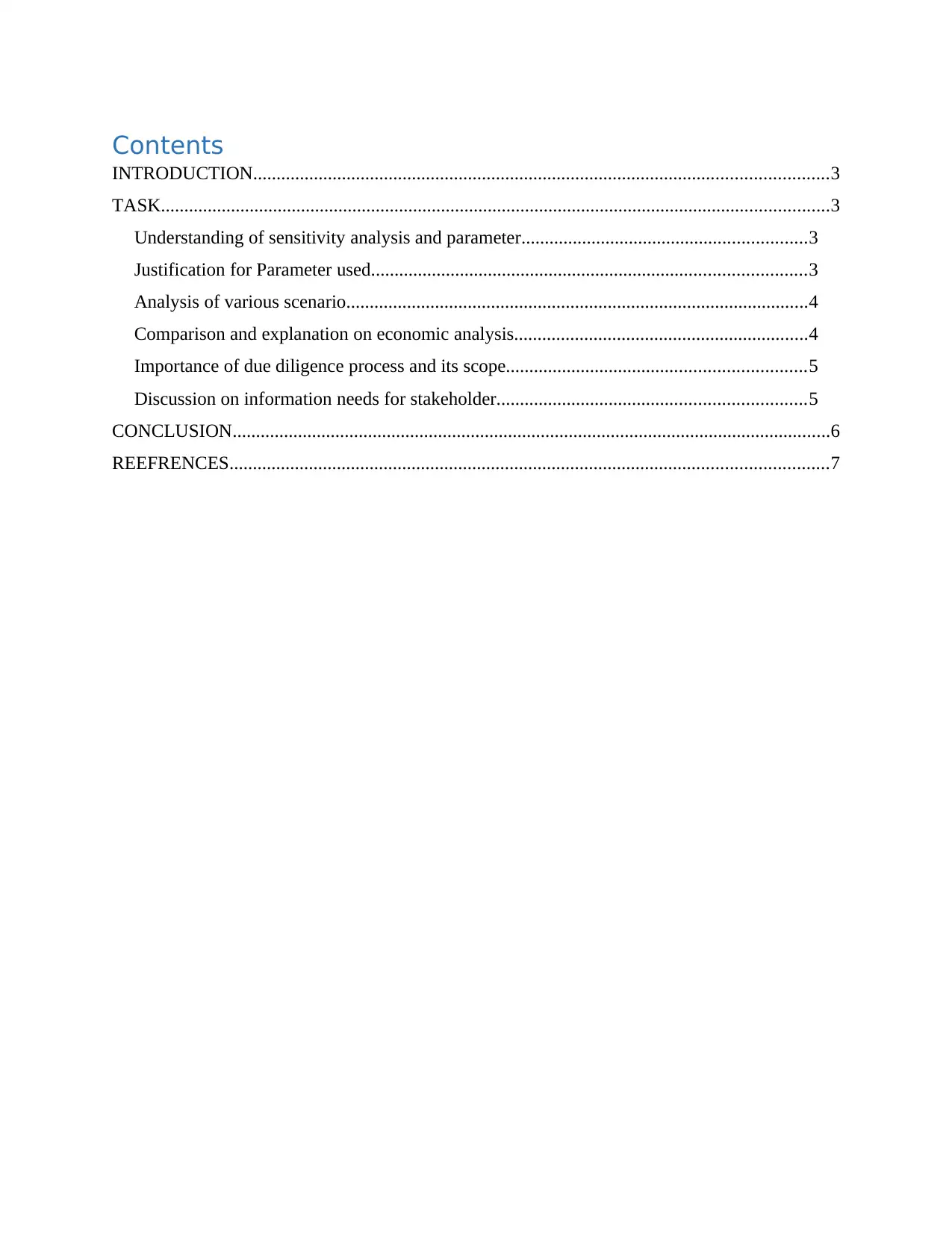
Contents
INTRODUCTION...........................................................................................................................3
TASK...............................................................................................................................................3
Understanding of sensitivity analysis and parameter.............................................................3
Justification for Parameter used.............................................................................................3
Analysis of various scenario...................................................................................................4
Comparison and explanation on economic analysis...............................................................4
Importance of due diligence process and its scope................................................................5
Discussion on information needs for stakeholder..................................................................5
CONCLUSION................................................................................................................................6
REEFRENCES................................................................................................................................7
INTRODUCTION...........................................................................................................................3
TASK...............................................................................................................................................3
Understanding of sensitivity analysis and parameter.............................................................3
Justification for Parameter used.............................................................................................3
Analysis of various scenario...................................................................................................4
Comparison and explanation on economic analysis...............................................................4
Importance of due diligence process and its scope................................................................5
Discussion on information needs for stakeholder..................................................................5
CONCLUSION................................................................................................................................6
REEFRENCES................................................................................................................................7
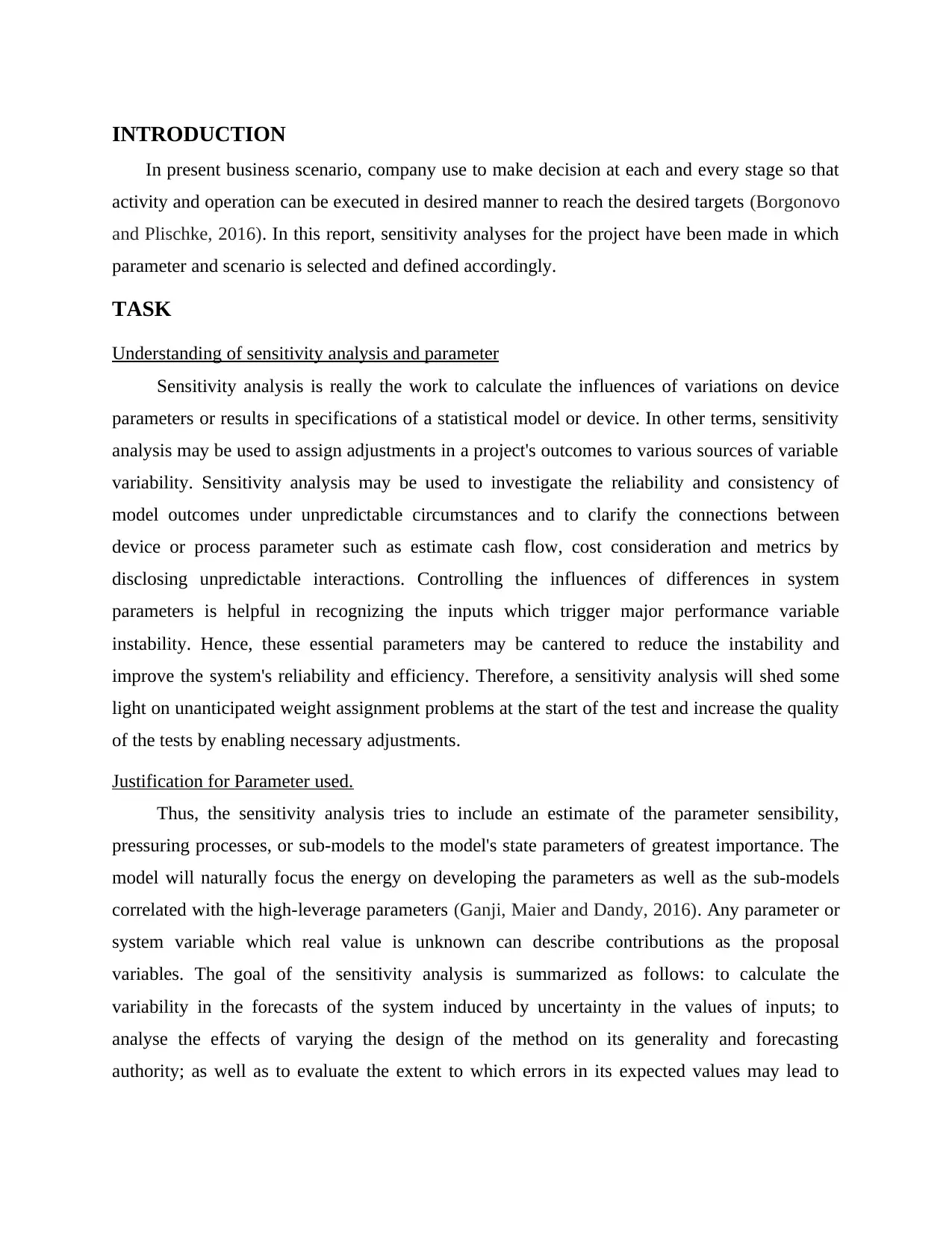
INTRODUCTION
In present business scenario, company use to make decision at each and every stage so that
activity and operation can be executed in desired manner to reach the desired targets (Borgonovo
and Plischke, 2016). In this report, sensitivity analyses for the project have been made in which
parameter and scenario is selected and defined accordingly.
TASK
Understanding of sensitivity analysis and parameter
Sensitivity analysis is really the work to calculate the influences of variations on device
parameters or results in specifications of a statistical model or device. In other terms, sensitivity
analysis may be used to assign adjustments in a project's outcomes to various sources of variable
variability. Sensitivity analysis may be used to investigate the reliability and consistency of
model outcomes under unpredictable circumstances and to clarify the connections between
device or process parameter such as estimate cash flow, cost consideration and metrics by
disclosing unpredictable interactions. Controlling the influences of differences in system
parameters is helpful in recognizing the inputs which trigger major performance variable
instability. Hence, these essential parameters may be cantered to reduce the instability and
improve the system's reliability and efficiency. Therefore, a sensitivity analysis will shed some
light on unanticipated weight assignment problems at the start of the test and increase the quality
of the tests by enabling necessary adjustments.
Justification for Parameter used.
Thus, the sensitivity analysis tries to include an estimate of the parameter sensibility,
pressuring processes, or sub-models to the model's state parameters of greatest importance. The
model will naturally focus the energy on developing the parameters as well as the sub-models
correlated with the high-leverage parameters (Ganji, Maier and Dandy, 2016). Any parameter or
system variable which real value is unknown can describe contributions as the proposal
variables. The goal of the sensitivity analysis is summarized as follows: to calculate the
variability in the forecasts of the system induced by uncertainty in the values of inputs; to
analyse the effects of varying the design of the method on its generality and forecasting
authority; as well as to evaluate the extent to which errors in its expected values may lead to
In present business scenario, company use to make decision at each and every stage so that
activity and operation can be executed in desired manner to reach the desired targets (Borgonovo
and Plischke, 2016). In this report, sensitivity analyses for the project have been made in which
parameter and scenario is selected and defined accordingly.
TASK
Understanding of sensitivity analysis and parameter
Sensitivity analysis is really the work to calculate the influences of variations on device
parameters or results in specifications of a statistical model or device. In other terms, sensitivity
analysis may be used to assign adjustments in a project's outcomes to various sources of variable
variability. Sensitivity analysis may be used to investigate the reliability and consistency of
model outcomes under unpredictable circumstances and to clarify the connections between
device or process parameter such as estimate cash flow, cost consideration and metrics by
disclosing unpredictable interactions. Controlling the influences of differences in system
parameters is helpful in recognizing the inputs which trigger major performance variable
instability. Hence, these essential parameters may be cantered to reduce the instability and
improve the system's reliability and efficiency. Therefore, a sensitivity analysis will shed some
light on unanticipated weight assignment problems at the start of the test and increase the quality
of the tests by enabling necessary adjustments.
Justification for Parameter used.
Thus, the sensitivity analysis tries to include an estimate of the parameter sensibility,
pressuring processes, or sub-models to the model's state parameters of greatest importance. The
model will naturally focus the energy on developing the parameters as well as the sub-models
correlated with the high-leverage parameters (Ganji, Maier and Dandy, 2016). Any parameter or
system variable which real value is unknown can describe contributions as the proposal
variables. The goal of the sensitivity analysis is summarized as follows: to calculate the
variability in the forecasts of the system induced by uncertainty in the values of inputs; to
analyse the effects of varying the design of the method on its generality and forecasting
authority; as well as to evaluate the extent to which errors in its expected values may lead to
⊘ This is a preview!⊘
Do you want full access?
Subscribe today to unlock all pages.

Trusted by 1+ million students worldwide
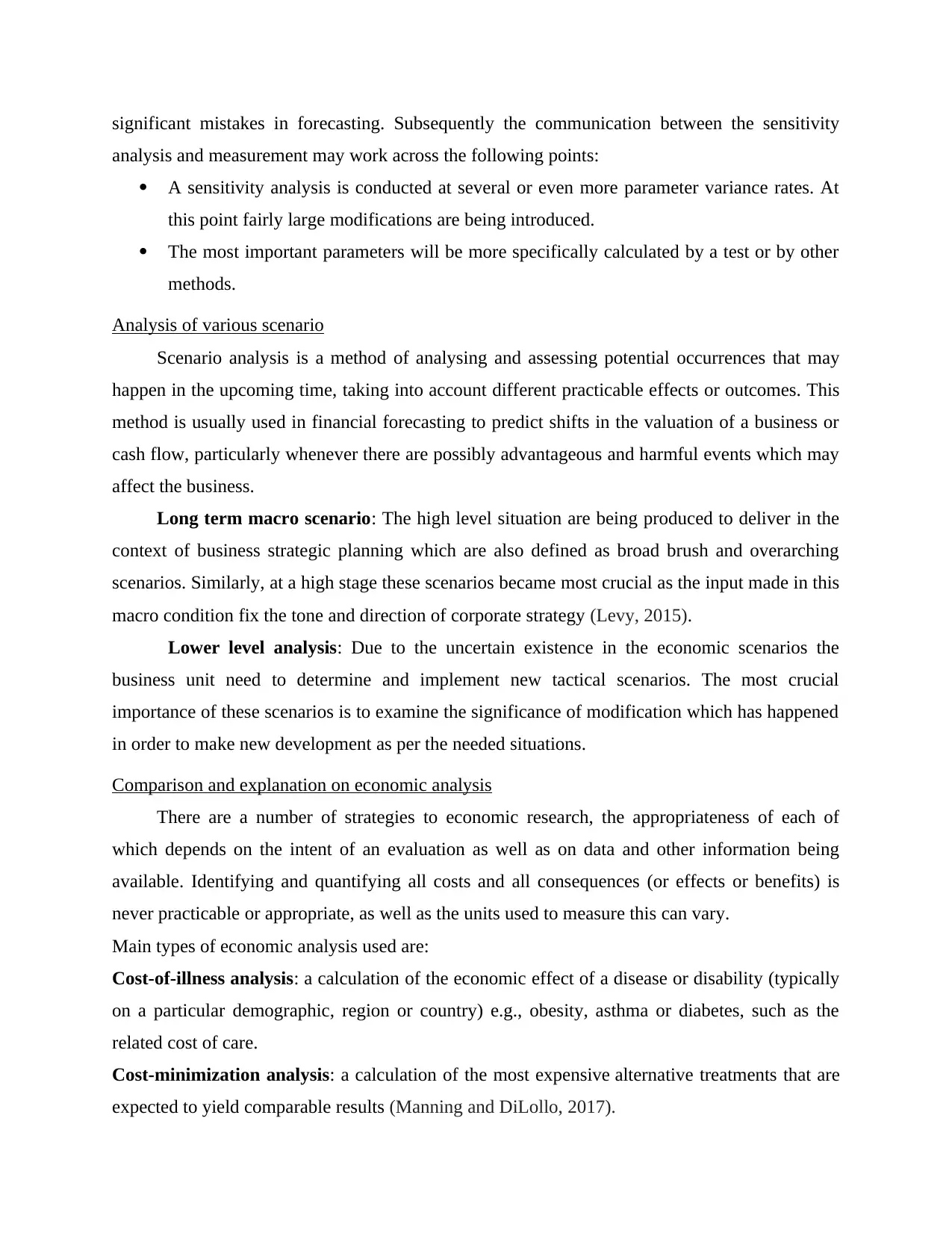
significant mistakes in forecasting. Subsequently the communication between the sensitivity
analysis and measurement may work across the following points:
A sensitivity analysis is conducted at several or even more parameter variance rates. At
this point fairly large modifications are being introduced.
The most important parameters will be more specifically calculated by a test or by other
methods.
Analysis of various scenario
Scenario analysis is a method of analysing and assessing potential occurrences that may
happen in the upcoming time, taking into account different practicable effects or outcomes. This
method is usually used in financial forecasting to predict shifts in the valuation of a business or
cash flow, particularly whenever there are possibly advantageous and harmful events which may
affect the business.
Long term macro scenario: The high level situation are being produced to deliver in the
context of business strategic planning which are also defined as broad brush and overarching
scenarios. Similarly, at a high stage these scenarios became most crucial as the input made in this
macro condition fix the tone and direction of corporate strategy (Levy, 2015).
Lower level analysis: Due to the uncertain existence in the economic scenarios the
business unit need to determine and implement new tactical scenarios. The most crucial
importance of these scenarios is to examine the significance of modification which has happened
in order to make new development as per the needed situations.
Comparison and explanation on economic analysis
There are a number of strategies to economic research, the appropriateness of each of
which depends on the intent of an evaluation as well as on data and other information being
available. Identifying and quantifying all costs and all consequences (or effects or benefits) is
never practicable or appropriate, as well as the units used to measure this can vary.
Main types of economic analysis used are:
Cost-of-illness analysis: a calculation of the economic effect of a disease or disability (typically
on a particular demographic, region or country) e.g., obesity, asthma or diabetes, such as the
related cost of care.
Cost-minimization analysis: a calculation of the most expensive alternative treatments that are
expected to yield comparable results (Manning and DiLollo, 2017).
analysis and measurement may work across the following points:
A sensitivity analysis is conducted at several or even more parameter variance rates. At
this point fairly large modifications are being introduced.
The most important parameters will be more specifically calculated by a test or by other
methods.
Analysis of various scenario
Scenario analysis is a method of analysing and assessing potential occurrences that may
happen in the upcoming time, taking into account different practicable effects or outcomes. This
method is usually used in financial forecasting to predict shifts in the valuation of a business or
cash flow, particularly whenever there are possibly advantageous and harmful events which may
affect the business.
Long term macro scenario: The high level situation are being produced to deliver in the
context of business strategic planning which are also defined as broad brush and overarching
scenarios. Similarly, at a high stage these scenarios became most crucial as the input made in this
macro condition fix the tone and direction of corporate strategy (Levy, 2015).
Lower level analysis: Due to the uncertain existence in the economic scenarios the
business unit need to determine and implement new tactical scenarios. The most crucial
importance of these scenarios is to examine the significance of modification which has happened
in order to make new development as per the needed situations.
Comparison and explanation on economic analysis
There are a number of strategies to economic research, the appropriateness of each of
which depends on the intent of an evaluation as well as on data and other information being
available. Identifying and quantifying all costs and all consequences (or effects or benefits) is
never practicable or appropriate, as well as the units used to measure this can vary.
Main types of economic analysis used are:
Cost-of-illness analysis: a calculation of the economic effect of a disease or disability (typically
on a particular demographic, region or country) e.g., obesity, asthma or diabetes, such as the
related cost of care.
Cost-minimization analysis: a calculation of the most expensive alternative treatments that are
expected to yield comparable results (Manning and DiLollo, 2017).
Paraphrase This Document
Need a fresh take? Get an instant paraphrase of this document with our AI Paraphraser
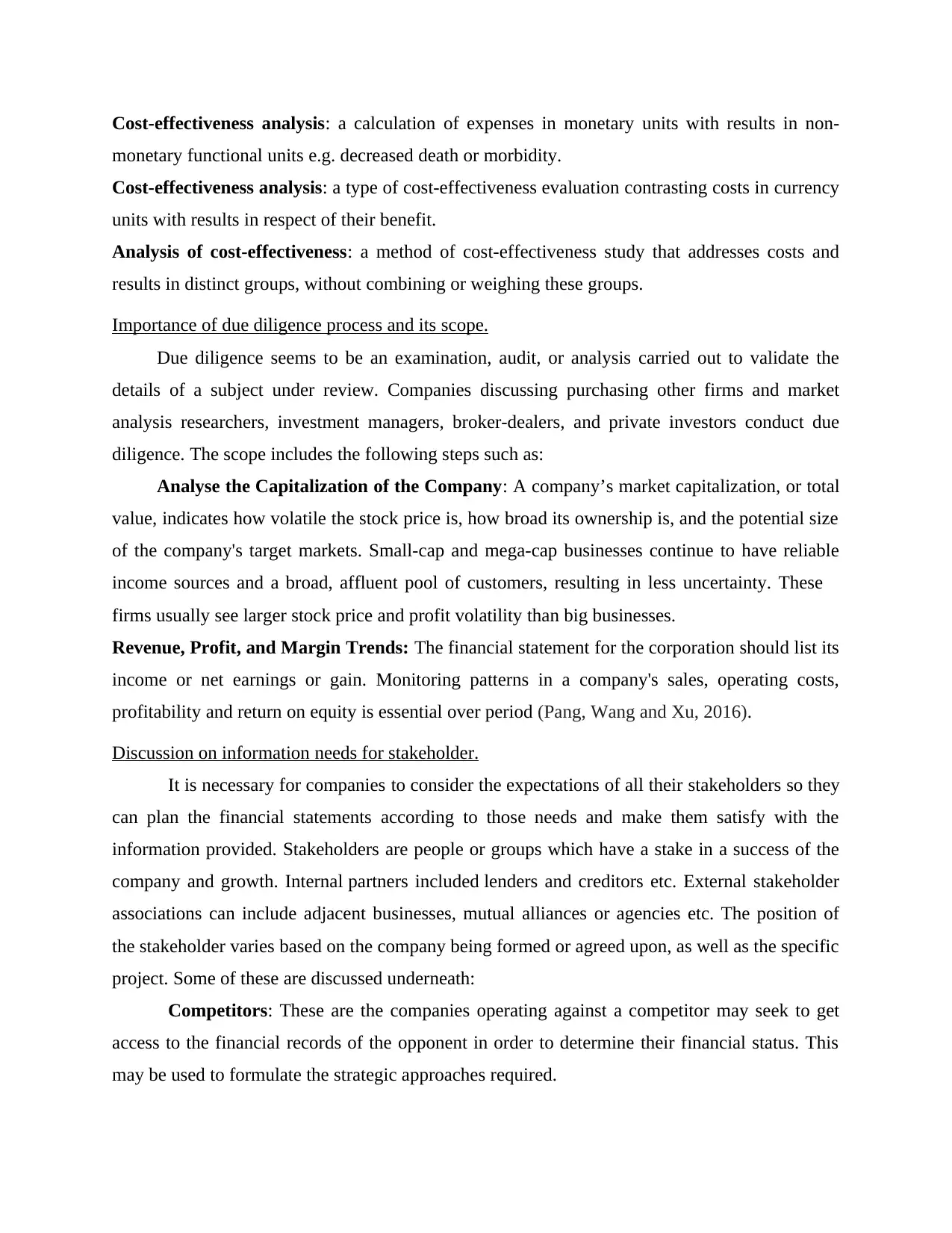
Cost-effectiveness analysis: a calculation of expenses in monetary units with results in non-
monetary functional units e.g. decreased death or morbidity.
Cost-effectiveness analysis: a type of cost-effectiveness evaluation contrasting costs in currency
units with results in respect of their benefit.
Analysis of cost-effectiveness: a method of cost-effectiveness study that addresses costs and
results in distinct groups, without combining or weighing these groups.
Importance of due diligence process and its scope.
Due diligence seems to be an examination, audit, or analysis carried out to validate the
details of a subject under review. Companies discussing purchasing other firms and market
analysis researchers, investment managers, broker-dealers, and private investors conduct due
diligence. The scope includes the following steps such as:
Analyse the Capitalization of the Company: A company’s market capitalization, or total
value, indicates how volatile the stock price is, how broad its ownership is, and the potential size
of the company's target markets. Small-cap and mega-cap businesses continue to have reliable
income sources and a broad, affluent pool of customers, resulting in less uncertainty. These
firms usually see larger stock price and profit volatility than big businesses.
Revenue, Profit, and Margin Trends: The financial statement for the corporation should list its
income or net earnings or gain. Monitoring patterns in a company's sales, operating costs,
profitability and return on equity is essential over period (Pang, Wang and Xu, 2016).
Discussion on information needs for stakeholder.
It is necessary for companies to consider the expectations of all their stakeholders so they
can plan the financial statements according to those needs and make them satisfy with the
information provided. Stakeholders are people or groups which have a stake in a success of the
company and growth. Internal partners included lenders and creditors etc. External stakeholder
associations can include adjacent businesses, mutual alliances or agencies etc. The position of
the stakeholder varies based on the company being formed or agreed upon, as well as the specific
project. Some of these are discussed underneath:
Competitors: These are the companies operating against a competitor may seek to get
access to the financial records of the opponent in order to determine their financial status. This
may be used to formulate the strategic approaches required.
monetary functional units e.g. decreased death or morbidity.
Cost-effectiveness analysis: a type of cost-effectiveness evaluation contrasting costs in currency
units with results in respect of their benefit.
Analysis of cost-effectiveness: a method of cost-effectiveness study that addresses costs and
results in distinct groups, without combining or weighing these groups.
Importance of due diligence process and its scope.
Due diligence seems to be an examination, audit, or analysis carried out to validate the
details of a subject under review. Companies discussing purchasing other firms and market
analysis researchers, investment managers, broker-dealers, and private investors conduct due
diligence. The scope includes the following steps such as:
Analyse the Capitalization of the Company: A company’s market capitalization, or total
value, indicates how volatile the stock price is, how broad its ownership is, and the potential size
of the company's target markets. Small-cap and mega-cap businesses continue to have reliable
income sources and a broad, affluent pool of customers, resulting in less uncertainty. These
firms usually see larger stock price and profit volatility than big businesses.
Revenue, Profit, and Margin Trends: The financial statement for the corporation should list its
income or net earnings or gain. Monitoring patterns in a company's sales, operating costs,
profitability and return on equity is essential over period (Pang, Wang and Xu, 2016).
Discussion on information needs for stakeholder.
It is necessary for companies to consider the expectations of all their stakeholders so they
can plan the financial statements according to those needs and make them satisfy with the
information provided. Stakeholders are people or groups which have a stake in a success of the
company and growth. Internal partners included lenders and creditors etc. External stakeholder
associations can include adjacent businesses, mutual alliances or agencies etc. The position of
the stakeholder varies based on the company being formed or agreed upon, as well as the specific
project. Some of these are discussed underneath:
Competitors: These are the companies operating against a competitor may seek to get
access to the financial records of the opponent in order to determine their financial status. This
may be used to formulate the strategic approaches required.

Customers: Whenever a customer chooses which manufacturer to use for a big contract,
they choose to evaluate their financial records first and access the information, in order to assess
a provider's financial capacity to stay in operation long sufficiently deliver the products or
services required in the agreement (Xu, 2015).
Trade union: A union wants a company's financial records to determine a corporation
'ability to repay the appropriate wages to the member countries it serves. There might also be
certain Financial Reporting consumers than the aforementioned. Exploring the financial records
for both groups provides many benefits. They will depend on the material found in these
financial reports and function as needed on that data.
CONCLUSION
In the end of report, it has been concluded that decision making help in evaluating the best
business case and making top most effort to increase the overall profitability of business in short
and long run. Due diligence throughout the financial system involves a check of financial
documents prior engaging into a potential deal with yet another Entity. Sensitivity analysis is an
important method for analysing problems relevant to model configuration fluctuations, or
attributes of inputs or parameters.
they choose to evaluate their financial records first and access the information, in order to assess
a provider's financial capacity to stay in operation long sufficiently deliver the products or
services required in the agreement (Xu, 2015).
Trade union: A union wants a company's financial records to determine a corporation
'ability to repay the appropriate wages to the member countries it serves. There might also be
certain Financial Reporting consumers than the aforementioned. Exploring the financial records
for both groups provides many benefits. They will depend on the material found in these
financial reports and function as needed on that data.
CONCLUSION
In the end of report, it has been concluded that decision making help in evaluating the best
business case and making top most effort to increase the overall profitability of business in short
and long run. Due diligence throughout the financial system involves a check of financial
documents prior engaging into a potential deal with yet another Entity. Sensitivity analysis is an
important method for analysing problems relevant to model configuration fluctuations, or
attributes of inputs or parameters.
⊘ This is a preview!⊘
Do you want full access?
Subscribe today to unlock all pages.

Trusted by 1+ million students worldwide
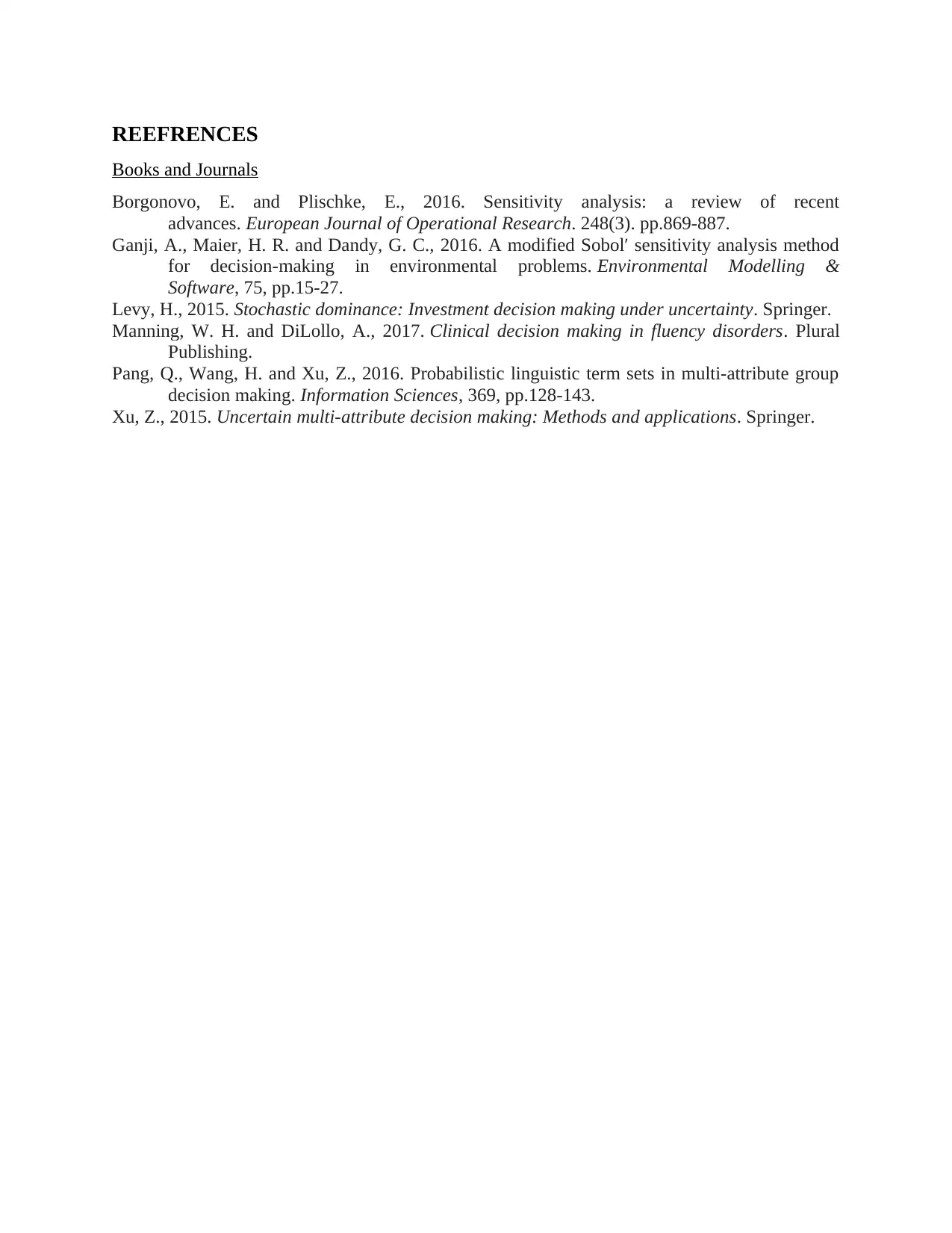
REEFRENCES
Books and Journals
Borgonovo, E. and Plischke, E., 2016. Sensitivity analysis: a review of recent
advances. European Journal of Operational Research. 248(3). pp.869-887.
Ganji, A., Maier, H. R. and Dandy, G. C., 2016. A modified Sobol′ sensitivity analysis method
for decision-making in environmental problems. Environmental Modelling &
Software, 75, pp.15-27.
Levy, H., 2015. Stochastic dominance: Investment decision making under uncertainty. Springer.
Manning, W. H. and DiLollo, A., 2017. Clinical decision making in fluency disorders. Plural
Publishing.
Pang, Q., Wang, H. and Xu, Z., 2016. Probabilistic linguistic term sets in multi-attribute group
decision making. Information Sciences, 369, pp.128-143.
Xu, Z., 2015. Uncertain multi-attribute decision making: Methods and applications. Springer.
Books and Journals
Borgonovo, E. and Plischke, E., 2016. Sensitivity analysis: a review of recent
advances. European Journal of Operational Research. 248(3). pp.869-887.
Ganji, A., Maier, H. R. and Dandy, G. C., 2016. A modified Sobol′ sensitivity analysis method
for decision-making in environmental problems. Environmental Modelling &
Software, 75, pp.15-27.
Levy, H., 2015. Stochastic dominance: Investment decision making under uncertainty. Springer.
Manning, W. H. and DiLollo, A., 2017. Clinical decision making in fluency disorders. Plural
Publishing.
Pang, Q., Wang, H. and Xu, Z., 2016. Probabilistic linguistic term sets in multi-attribute group
decision making. Information Sciences, 369, pp.128-143.
Xu, Z., 2015. Uncertain multi-attribute decision making: Methods and applications. Springer.
1 out of 7
Related Documents
Your All-in-One AI-Powered Toolkit for Academic Success.
+13062052269
info@desklib.com
Available 24*7 on WhatsApp / Email
![[object Object]](/_next/static/media/star-bottom.7253800d.svg)
Unlock your academic potential
Copyright © 2020–2025 A2Z Services. All Rights Reserved. Developed and managed by ZUCOL.





